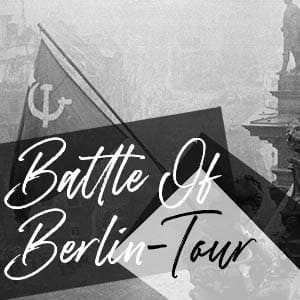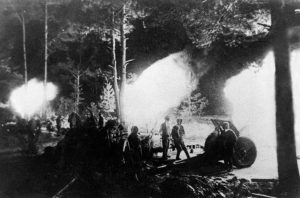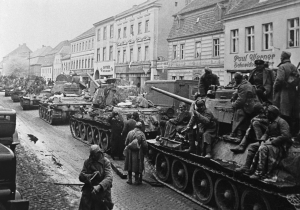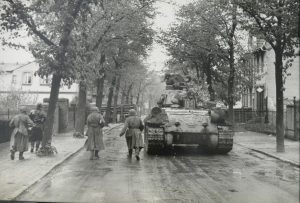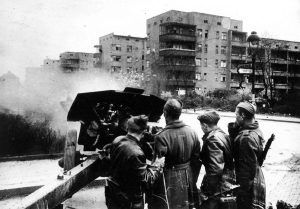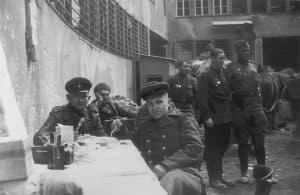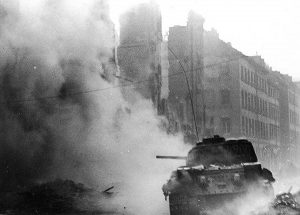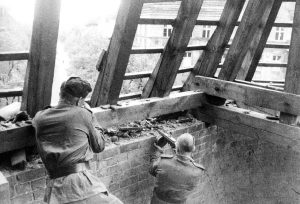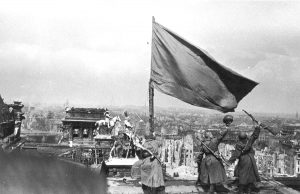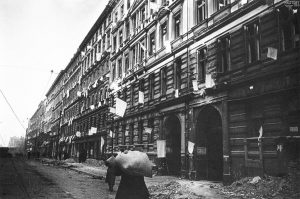At 11am on April 24th 1945, General Helmuth Weidling was informed that following his successful meeting with Adolf Hitler the previous day he had been promoted to Commandant of the Berlin Defence Area – contrary to a previous order that he should be executed for desertion.
He thus became the fifth commander of the Defence Area in less than three months and the third within two days.
The forces available to Weidling to defend the city were far from capable of the task and included roughly 45,000 soldiers in several severely depleted divisions – some part of the German Army and others part of the SS.
Additionally another 40,000 Volkssturm men – veterans of the First World War or simply men conscripted into the fight – joined police units and Hitler Youth to fill the ranks.

Weidling would command the forces in Berlin across eight sectors – designated ‘A’ through to ‘H’ – with battlefield commanders assigned to each area.
- In the west of the city was the 20th Infantry Division
- To the north was the 9th Parachute Division
- To the north-east was the Müncheberg Panzer Division
- To the south and south-east of the city was the 11th SS Panzergrenadier Division Nordland
- In reserve, Weidling had the 18th Panzergrenadier Division in Berlin’s central Mitte district.
The three flak towers in the city – Zoo, Humboldthain, and Friedrichshain – would also aid in the defense of the city. With plenty of ammunition for their 128mm and 20mm guns. All three had coordinates of every major building throughout the city in their fire control systems – with spotters posted on rooftops to observe enemy troops movements and report back to the towers gunners.
Hitler had personally appointed SS Brigadeführer Wilhelm Mohnke the Battle Commander (Kommandant) for the central government district (District Z or Zitadelle) that included the Reich Chancellery and Führerbunker. Mohnke had served as head of the 1st SS Panzer Division Leibstandarte SS Adolf Hitler and was wounded in battle twice by air attacks – once suffering a severe leg wound in the Balkans that would lead doctors to advise that his leg should be amputated. A decision that Mohnke overrode.
Although considered battle hardened by his service on both the eastern and western fronts, Mohnke would only have two weak regiments of around 2,000 men as part of his battle group – Kampfgruppe Mohnke (Battle Group Mohnke) – and due to their position in the centre of the city they would suffer heavily under the intense bombardment of Soviet artillery aimed at the government quarter.
Mixed in among the bands of defenders were the millions of inhabitants of Berlin – the vast majority being female – bracing for the avalanche of chaos and suffering that would follow over the next week. The final act in a tragedy that had seen the lives of millions more extinguished across the European continent.
SS execution squads roamed the city looking for deserters – or suspected ‘Seydlitz Troops’ who would be summarily executed or hanged from lampposts.
Nightmarish atrocity stories were already spreading through the city, with tales of Soviet rapes and executions arriving with the masses of refugees from the eastern front. Some finding solace in dark humour would joke: “better a Russian on the belly than an Ami on the head”. Referring to the Allied air raids that had finally ceased days earlier.
The tragic reality would soon become all too obvious.
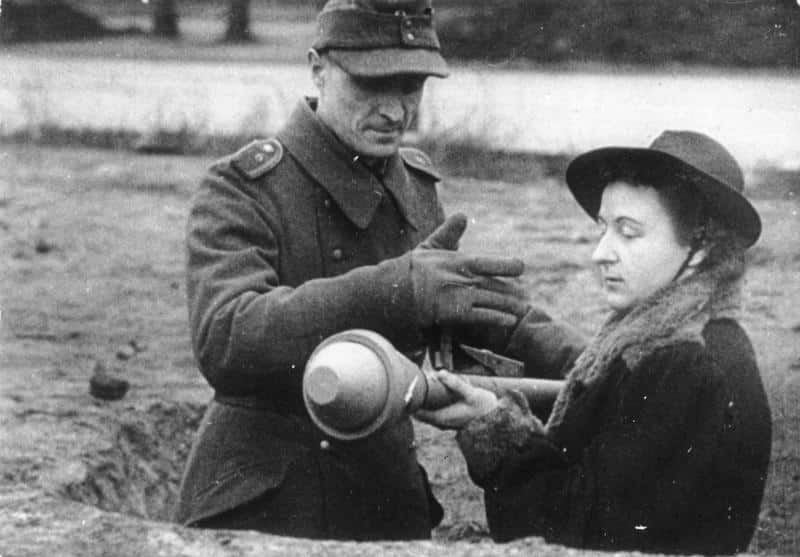
On the morning of April 24th, fierce fighting was taking place at the Teltow Canal – between the troops of Ivan Konev’s 1st Ukrainian Front and the 20th Panzergrenadier Division. With the latter successfully eliminating a bridgehead that the Red Army had established earlier at Lankwitz.
The previous evening nearly 3,000 guns and heavy mortars had been positioned to fire north across the canal – and into the city – bombarding the warehouses sheltering the Volkssturm detachments positioned alongside the 18th and 20th Panzergrenadier Division as waves of Soviet aviators joined in the pummelling of the defences.
With the attack starting at 6am on April 24th, this would be an even greater concentration of fire than Konev had unleashed on the Neisse river crossing eight days earlier.
From a rooftop observation post, Marshal Konev was able to look out across the city of Berlin and assess the scene:
“From the roof of this building we had a fine view of Berlin, especially its southern and south-western districts. The left flank could be seen as far as Potsdam. Our field of vision extended to the right flank where, on the outskirts of Berlin, troops of the 1st Ukrainian Front and the 1st Belorussian Front were to link up.
I remember how vast the city appeared to me. I noted the massive old buildings, in which the district that lay before me abounded, and the density of these buildings; I took note of everything that might complicate our task of capturing Berlin. I also noticed the canals, rivers, and streams that crossed Berlin in different directions and were plainly visible from above. Such a multiplicity of water obstacles promised additional difficulties.
Before us lay a frontline city, besieged and prepared for defence. Had there been a reasonable government at the head of Germany, it would have been logical, under the circumstances, to expect from it an immediate surrender. Only surrender could have preserved what still remained of Berlin; it would also have saved the lives of many of its citizens. But it was apparently futile to expect a reasonable decision and we had to fight it out. As I gazed upon Berlin I reflected that its end would spell the end of the war and that the sooner we took the city the sooner the war would be over.”
The ad hoc nature of the city’s defence and the desperate finality of the fight that would take place in Berlin meant that the Soviet ground forces were expecting to engage in brutal urban fighting that would mean blood shed for every metre advanced.
Red Army tank driver, Alexander Shelomotov, moving up alongside the 29th Guards Motorized Rifle Brigade would comment on April 24th:
“In the evening our team, overcoming fierce resistance from the Germans, came to the southern outskirts of Berlin. On the streets everywhere were barricades with disguised anti-aircraft guns hidden behind. In basements and backyards German soldiers with bazookas lurked and the fighting was hard.”

The Soviet 5th Shock Army and 1st Guards Tank Army of Georgy Zhukov’s 1st Belorussian Front would finally overcome a counter-attack by the German LVI Panzer Corps and reach the Berlin S-Bahn ring railway on the north side by the evening of April 24th. The 5th Shock Army would also cross the Spree farther north of Treptow Park with the assistance of the gunboats of the Dnepr Flotilla. While an additional force would head towards Spandau, west of the city, aiming to encircle Berlin.
Encountering fierce resistance from prepared positions in the north, soldiers of the 12th Guards Rifle Corps came up against the mammoth Humboldthain Flak Tower on April 24th, and using artillery support overwhelmed the surrounding area to enter deeper into the Berlin Wedding district. The tower could only be contained and bypassed and remained operational until the end of the battle. Inside was a young German infantryman – part of an ad hoc unit gathered there and held in reserve – named Wolfgang Karow.
“(On April 24th) we were ordered to try and get some sweets from the Hildebrandt Chocolate factory on Pankestrasse, which was nearby in no man’s land, so we put on some large Luftwaffe rucksacks and set off. We arrived without any trouble, but then had to detain an NSDAP (Party) official, who tried to prevent us from entering at gunpoint. We were able to fill our rucksacks with chocolates and return to the bunker without suffering any casualties, and were warmly greeted by our comrades.” – Wolfgang Karow

The much vaunted counterattack from SS Obergruppenführer Felix Steiner that Adolf Hitler had so emphatically insisted take place three days earlier, however, had failed to materialise. Reaching its final line of advance on April 24th – by entering the towns of Klosterfelde and Zehlendorf north of Berlin before being thrown back by a superior foe.
The remaining elements of General Theodor Busse’s 9th Army, which fought against the head-on drive of Zhukov’s 1st Belorussian Front at the Seelow Heights from April 16th was finally surrounded on April 24th – after being pushed into the Spree Forest south-east of Berlin. Elements of the 3rd Army of the 1st Belorussian Front linked up with the 1st Ukrainian Front’s 28th Army at Teupitz completing the encirclement – and forming what would come to be known as the Halbe Pocket. This would consist of around 80,000 men, some 80 tanks, and between 150 and 200 vehicles. The envelopment by the two Soviet pincers meant that these men would spend the rest of the war attempting to break out from the encirclement – with around one third eventually making it to the west. The rest would be either killed or captured by Soviet forces.
Grand Admiral Dönitz, based in the north of Germany, was signalling that he was prepared to send all available German sailors to Berlin as reinforcements to defend the capital. The plan to crash land these troops in Junkers 52s in the centre of the city would fortunately – at least for the sailors – never be realised.

On the evening of April 24th, at around 10pm, the last German reinforcements made it into Berlin – French SS fighters who were part of 33rd Waffen Grenadier Division of the SS Charlemagne (1st French). Destined to become the last defenders of Defence Sector Zitadelle and Adolf Hitler’s Führerbunker and among the last fighters to surrender in the city.
Summoned to the city from an SS training camp near Neustrelitz, SS Charlemagne Brigadeführer Gustav Krukenberg roused his men and asked for volunteers – as the two armoured personnel carriers and three heavy trucks at his disposal could only take a limited number. Although the majority wanted to go, Krukenberg along with Hauptsturmführer Henri Joseph Fenet selected around 300 men – including the 72 year old division chaplain, Monsignor Count Mayol de Lupe.
These troops were forced to take a long detour in arriving to avoid the Soviet advance columns. Leaving from their base early on April 24th, the convoy travelled via Neuruppin, reaching the Berlin-Hamburg highway near Friesack – and the masses of refugees and fleeing soldiers clogging up the route.
Eventually the unit reached the Grünewald forest near the Berlin Olympic Stadium via Marquardt, Glienicke and Gatow without encountering any of the Berlin defence apart from three Hitler Youth armed with Panzerfausts and patrolling on their bicycles.
According to Krukenberg, the big bridges across the Havel on the strategic Berlin-Spandau road at this time were barricaded but unguarded.
As the last regular unit to arrive in the city, the Charlemagne had just made it into Berlin in time – before the complete encirclement of the city by the Soviet Fronts.
**
Our Related Tours
Want to learn more about the Battle of Berlin? Check out our Battle of Berlin tours to explore what remains of this important urban battlefield.
To learn more about the history of Nazi Germany and life in Hitler’s Third Reich, have a look at our Capital Of Tyranny tours.
Bibliography
Beevor, Antony (2003) Berlin: The Downfall 1945 | ISBN 978-0-14-028696-0
Hamilton, Aaron Stephan (2020) Bloody Streets: The Soviet Assault On Berlin | ISBN-13 : 978-1912866137
Kershaw, Ian (2001) Hitler, 1936–1945: Nemesis | ISBN 0-393-04994-9
Le Tissier, Tony (2010) Race for the Reichstag: the 1945 Battle for Berlin | ISBN: 978-1848842304
Le Tissier, Tony(2019) SS Charlemagne: The 33rd Waffen-Grenadier Division of the SS | ISBN: 978-1526756640
Mayo, Jonathan (2016) Hitler’s Last Day: Minute by Minute | ISBN: 978-1780722337
McCormack, David (2017) The Berlin 1945 Battlefield Guide Part I the Battle of the Oder-Neisse | ISBN: 978-1781556078
McCormack, David (2019) The Berlin 1945 Battlefield Guide Part II The Battle of Berlin | ISBN: 978-1781557396
Moorhouse, Roger (2010) Berlin at War | ISBN: 978-0465028559
Ryan, Cornelius (1966) The Last Battle | ISBN 978-0-671-40640-0
Sandner, Harald (2019) Hitler – Das Itinerar, Band IV (Taschenbuch): Aufenthaltsorte und Reisen von 1889 bis 1945 – Band IV: 1940 bis 1945 | ISBN: 978-3957231581
Shirer, William L. The Rise and Fall of the Third Reich | ISBN 978-1451651683.

